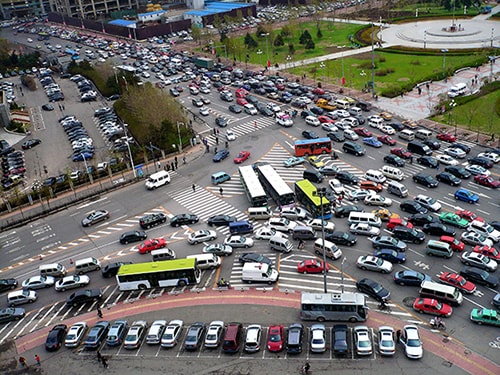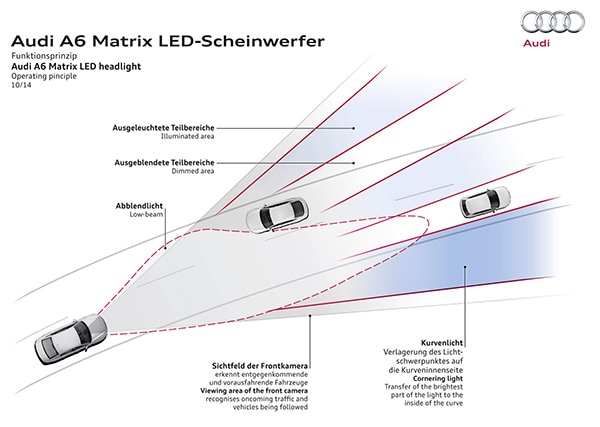Rise of the Machine
It is the year 2035 and the manual driving of cars has been banned in California for the last three years. Many trace the demise of the human driver to the great freeway pileup of 2031, an accident involving over 72 vehicles, 20 fatalities and multiple lawsuits, which was eventually traced back to a teen driver distracted by texting. As Governor Schwarzenegger ("I said I’d be back") signed the legislation that made autonomous vehicles mandatory, he looked straight at the multitude of assembled cameras and announced, red eyes glowing: "Finally we have come to acknowledge the power of the machine over puny humans."

Figure 1: Archival photo of what traffic was like when vehicles were 100% controlled by humans. (Circa 2012.) Credit: iStock
In reality, the rise of the machine can be traced back much earlier. The car's takeover of the roles of both vehicle and driver was methodical. At first it was presented as offering helpful features to the human driver. The introduction of a cockpit light to help you read. Power steering was developed to help poor weak humans turn their steering wheel. Windows opened at the touch of button. Car radios morphed into "Car Entertainment Systems" with everything from high definition TV for the rear passengers to Satellite radio for front seat occupants. More electronic convenience features followed, such as seats that could heat in winter and remember occupants' preferred seat positions. Drivers gratefully embraced safety features: air bags to protect the driver from the car, followed by ABS (which when you think about it, was designed really to protect the car from the driver. After all, the car could brake faster and was better at avoiding skids than most human drivers). Image sensors were used to scan the iris of a seat occupant to detect a drowsy driver and sound an alarm. Collision detection systems varied from those that sounded an alarm in case of a pending impact to those that took over from the driver and applied the brakes. Lane detection systems vibrated the steering wheel or alarmed when drivers allowed their cars to drift across a white line without indicating. More and more of the electronics in cars were being developed to compensate for the fact that, let’s face it, humans were not very good at getting vehicles from point A to B safely.
They say that for people, the eyes are a window to the soul. Well in cars it is the lights that are the window to the soul of the machine. At first electronics were used to help lights look good (mood lighting for the interior, for example) but this soon evolved to making lights better and more driver friendly. Image sensors eliminated the manual switching between high and low beams by identifying oncoming traffic and making an automatic adjustment. LED bulbs led to the concept of pixel light-based anti-glare high beams that could be used to create dark spots in the road ahead to avoid blinding drivers or pedestrians. It also led to pivoting headlamps that peeked around bends and used GPS to identify oncoming geographic features and adapt in advance for maximum illumination (there were early demonstrations recorded on video from BMW, Audi and Mercedes). Of course, this was all because human drivers could not see in dark: adopting ultra-low light image sensors and projecting onto heads-up displays has by now obsoleted the idea of headlights.

Figure 2: Image sensors eliminated the manual switching between high and low beams by identifying oncoming traffic and making an automatic adjustment. Shown: Audi A6 Matrix LED Headlight technology. Image courtesy of Audi-mediacenter.com, circa 2015.
Thinking back as far as 2015, high end cars were offering an automatic parking assist feature for painless parallel parking. Audi had already gone a step further and was showing off on YouTube its self-parking car which could autonomously find a free space, park, and then return to pick up the driver. The same system was being demonstrated as ideal for letting the car drive itself in stop-start traffic jams.
But when did people get comfortable with the idea that a car could actually drive itself safer than real people? For almost a decade, passengers had insisted on airline companies providing two pilots in a cockpit although for the most part, planes flew on autopilot. There was just that comfort factor of believing there was a human there, willing and ready to jump to the rescue if something went wrong. I believe the tide of public opinion started to turn in 2017 when one company, tired of all the controversy over drone delivery, teamed up with another large corporation to develop its now famous Urban Parcel Automated Delivery System (UPADS). People became comfortable with these golf cart sized vehicles trucking down bike lanes as they delivered their goods to waiting customers. UPADS connected to GPS, traffic reports and most city traffic networks (including the traffic light control systems) to plot the most efficient routes throughout the city. They built on existing Image Sensing systems to detect and avoid forward and rear collisions, to stay within lanes, and to read and follow traffic signs (following a breakthrough that finally allowed sensors to compensate for the flicker in LED signs). Millions of accident free deliveries helped turn the tide of public opinion to the idea that a car may not need a driver.
Of course, not every traveler embraces the idea of letting the car do all the work. Most states seem set to adopt California’s Autonomous Car law, but there are the usual holdouts, where motor bikers can ride without helmets and drivers can still experience the thrill of gunning the engine and racing down the open road, doing what no machine will do – breaking the speed limit.
Disclaimer: As the leading supplier of Image Sensors to the Automotive, ON semiconductor rejects sole blame for the evolution of the Autonomous vehicle but admits to being a key enabler.
Disclaimer: Due to the possibility of time travel (as yet to be invented as of this writing), the author maintains that this article is true as of his experience in the year 2035, and any other accounts may be pure speculation.